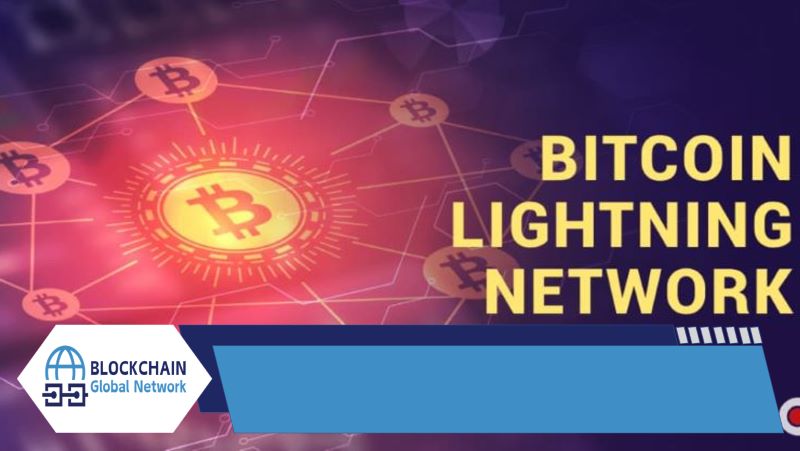What is Bitcoin Lightning Network? This cutting-edge solution aims to revolutionize cryptocurrency transactions by providing a faster and more cost-effective way to transfer Bitcoin. By enabling off-chain transactions, the Lightning Network reduces congestion on the main blockchain, allowing users to make instant payments with minimal fees. In this article, we will delve into the mechanics of the Bitcoin Lightning Network and its significant impact on the future of digital currency transactions.
What is Bitcoin Lightning Network?
The Bitcoin Lightning Network is a scaling solution for Bitcoin, designed to improve the network’s transaction capacity. With Bitcoin frequently experiencing congestion and high transaction fees during peak demand periods, the Lightning Network was created to address these issues.

Concept: A Second Layer for Enhanced Transactions
The Lightning Network is a second layer built on top of Bitcoin. It enables faster and cheaper transactions by creating dedicated payment channels between two parties. This means users can perform multiple transactions without having to record every transaction on the main blockchain.
How Payment Channels Function
When two users want to transact, they can establish a payment channel. They will deposit an amount of funds into this channel and can perform multiple transactions with each other without broadcasting them on the blockchain. Eventually, when they decide to close the channel, the final balance will be recorded on the main blockchain. This minimizes the volume of transactions on the blockchain, reducing transaction fees and confirmation times.
Challenges of Complexity and Security
While the Lightning Network offers many benefits, it also faces some challenges, such as requiring a more complex system to set up and manage payment channels, and security concerns related to closing channels without risking asset loss.
The Role of Bitcoin Lightning Network

The role of the Bitcoin Lightning Network in the cryptocurrency ecosystem is crucial, especially in addressing some of the fundamental issues faced by Bitcoin and other cryptocurrencies.
- Solving network congestion: The Lightning Network relieves the main Bitcoin network by processing transactions off-chain. This not only reduces network congestion but also increases transaction speed, allowing users to perform more transactions in a shorter time.
- Increasing scalability: One of the major challenges facing Bitcoin is scalability. The Lightning Network acts as a scaling solution for Bitcoin, allowing millions of transactions to occur simultaneously without compromising network performance. This is crucial for large-scale Bitcoin adoption.
- Enhancing security: Although Lightning Network transactions occur off-chain, it still maintains Bitcoin’s security. The Lightning Network uses smart contracts to ensure that transactions are secure, allowing only authorized parties to perform transactions when the conditions are met.
- High interoperability: The Lightning Network allows for interaction between different networks, not limited to the Bitcoin ecosystem. This means users can convert between different cryptocurrencies or make transactions across networks without the need for intermediary exchanges.
- Fostering the development of applications and services: The Lightning Network opens up opportunities for developers to build new applications and services based on this technology. The development of payment applications, digital wallets, and decentralized platforms (DApps) will be driven by the speed and cost-effectiveness of the Lightning Network.
- Encouraging Bitcoin adoption: With its benefits of transaction speed and low costs, the Lightning Network encourages more users and businesses to adopt Bitcoin. This can create a positive environment for using Bitcoin as a daily means of payment, thereby promoting wider acceptance of cryptocurrency.
- Reducing transaction costs: One of the most prominent roles of the Lightning Network is its ability to minimize transaction costs. This benefits not only consumers but also businesses, allowing them to save costs when making transactions with Bitcoin.
- Improving user experience: Ultimately, the Lightning Network improves the user experience by enabling instant transactions without waiting for confirmation from the main network. This provides convenience and speed for users when making daily transactions.
The role of the Bitcoin Lightning Network is not only a technological solution to Bitcoin’s current problems but also opens up many new opportunities for the development and widespread adoption of cryptocurrency in the future. The Lightning Network is gradually establishing itself as a vital part of the blockchain and cryptocurrency ecosystem.
The Future of Bitcoin Lightning Network

The future of What is Bitcoin Lightning Network promises to bring about many positive changes to both the Bitcoin ecosystem and other cryptocurrency platforms.
- Expanding application possibilities: The Lightning Network has immense scalability potential, meaning it will support many new applications and services in the future. Developers can leverage this platform to create more innovative products and services, from online payments to decentralized finance (DeFi) solutions.
- Cooperating with other blockchains: A future trend could be cooperation between the Bitcoin Lightning Network and other blockchains to create cross-chain payment solutions. This not only enhances flexibility but also promotes interaction between different cryptocurrency ecosystems, expanding global payment capabilities.
- Improving security technology: With the increasing demand for security in cryptocurrency transactions, the Lightning Network will need to continuously improve its security measures. The future may see the development of new security solutions to protect users from attacks and fraud.
- Increasing awareness and adoption: As the Lightning Network becomes more popular, user and business adoption will increase. Businesses can start integrating the Lightning Network into their payment systems, encouraging consumers to use Bitcoin for daily transactions.
- Improving user experience: The development of the Lightning Network will bring about a better user experience by reducing transaction times and costs. When users can make transactions quickly and cost-effectively, they will find it easier to adopt Bitcoin for everyday needs.
- Developing infrastructure: To support the development of the Lightning Network, infrastructure needs to be upgraded. This may include developing Lightning wallets, Lightning-supported trading platforms, and other technological solutions to ensure system compatibility and efficiency.
- Integrating with other sectors: The Bitcoin Lightning Network is not limited to the cryptocurrency sector but can also be integrated into many other areas such as e-commerce, online gaming, and traditional financial services. This can create new opportunities for businesses and users in these sectors.
- Withstanding competition: As many other blockchain projects are developing similar solutions, the Lightning Network needs to maintain its position in the market. This may involve improving technology and development strategies to remain competitive with other payment solutions.
- Role in policy decisions: The Lightning Network can also play a significant role in policy decisions related to cryptocurrency. Legislators and regulators will need to better understand how the Lightning Network works and its benefits to develop appropriate regulations and support the development of this technology.
- Towards sustainability: The future of the Lightning Network also needs to focus on sustainability and energy consumption. As the world becomes more focused on environmental protection, the Lightning Network may need to develop more energy-efficient solutions to align with this trend.
What is Bitcoin Lightning Network is a transformative innovation that significantly improves the efficiency of cryptocurrency transactions. By facilitating faster and cheaper payments, the Lightning Network paves the way for Bitcoin’s wider adoption in everyday transactions. As this technology continues to evolve, it holds the potential to reshape the future of digital payments. Stay informed with updates from Blockchain Global Network.

RELATED POSTS
ABLY Airdrop: A comprehensive guide on how to participate
In the rapidly growing cryptocurrency...
Remis Launches: A New Era in GameFi Innovation
On February 1, 2025, Remis...
What is the ALIENX Airdrop and How to Participate Effectively
Do you want to invest...
Understanding the Stock to Flow Model – How to Optimize Investment
The Stock to Flow Model...
Easily Join the TENEO Airdrop with This Step-by-Step Guide
The TENEO Airdrop is a...
Yala Airdrop – A Great Opportunity to Earn Free Tokens Today
Discover Yala Airdrop now –...
What is the Swell Airdrop? Detailed guide to participation
The Swell Airdrop is an...
4 Reasons You Should Pay Attention to Banana Zone Crypto Today
Banana Zone Crypto is gaining...
Future of On-Chain Code Audits: Revolutionizing Collaborative Cybersecurity
Enhance blockchain security with on-chain...
Gradient Network Airdrop – How to Earn Points and Receive Rewards
Are you ready to dive...
Kroma Airdrop Season 2 – Opportunity to Earn KRO and Explore Web3
Kroma Airdrop Season 2 is...
DuckChain Airdrop: Great opportunity to get free Tokens
In the context of rapid...
Can you mine Dogecoin? – Exploring the Mechanics behind it
Can you mine Dogecoin? This...
Pencils Protocol: Optimizing DeFi yields on Scroll
In the vast landscape of...
Starknet: A Layer-2 scaling solution for Ethereum
Starknet is rapidly gaining traction...
Is Ledger open source? 95% of Ledger’s software is open source
Wondering “Is Ledger open source?”...